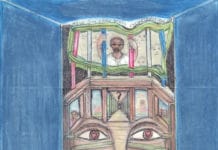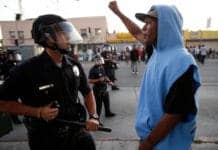by Chriss Garcia
By 1910, Mexican President Porfirio Diaz solidified his place in the annals of Mexican history. As an elitist oligarch, he corruptly governed the country with a crony-ite unashamedness that was reinforced by the caudillo (chieftain-type strongman) support base he espoused.
Under his presidency, the large landowners (latofundistas) and the haciendas increased, as did their wealth, privilege and autonomy. The haciendas (estates) served as a peonage system for their laborers, who were largely landless, poor and Indian. These laborers, by design, would find themselves bound to the land by way of perpetual indebtedness, resembling indentured servitude, with the caudillos readily available to suppress and disperse any discontent with swift violence.

Much of the fertile Mexican land once owned by the church until “La Reforma” under Benito Juarez was now controlled by privileged elitists who had created an oligarchic Mexican society and government. Widespread rebellion had been brewing across the country, which would birth the Mexican Revolution of 1910.
Francisco Madero, Pancho Villa, Pascual Orozco, Venustiano Carranza and Emiliano Zapata had amassed to overthrow Diaz and his supporters and usher in a new progressive state for the Mexican people. These principal leaders of the revolution by their strength would see Diaz resign the presidency by 1911 and in turn see Madero elected in 1911 as president. However, the revolution continued.
Madero’s reforms were slow to come. Zapata would not wait and consequently forcefully took land under hacienda control and designated it Indian ejidos (communally-held lands). Madero was assassinated in 1913 by a former general under Diaz, Victoriano Huerta, who assumed the presidency until his death in 1914.
Carranza claimed the presidency himself despite staunch opposition by Villa and Zapata. Carranza oversaw the drafting and consecration of Mexico’s new progressive Constitution of 1917. However, Carranza would be idle in the implementation of its key provisions.
Emiliano Zapata, himself a Zapotec Indian from the state of Morelos, fluent in the indigenous tongue of Nahuatl, could not and would not rest while his own kind remained on the fringes of society, exploited by their countrymen. Zapata had forged a very respectful fighting force in Southern Mexico comprised mostly of fellow Indians.
That force would become instrumental in defeating Huerta and bringing forth the many successes of the revolution. Zapata had pushed for land reform in the Plan de Ayala – political, social and economic inclusion and equality for all indigenous people.
Since the “conquest” of Mexico by the Spanish, disease and indigenous factionalization, the Indian had been relegated to second class citizen – customarily, culturally, linguistically besieged by the capitalist-imperialist powers that be. Zapata was an advocate for the dispossessed, declaring “herra y libertad” (land and liberty).
Emiliano Zapata, himself a Zapotec Indian from the state of Morelos, fluent in the indigenous tongue of Nahuatl, could not and would not rest while his own kind remained on the fringes of society, exploited by their countrymen.
For his determination, he was ambushed by Carranza’s hitmen in 1919. Zapata’s unflinching commitment to the interests of the indigenous, which he paid for with his life, earnestly endeared him in the hearts and minds of Mexicans.
Zapata’s legacy of integrity, dignity, self-determination and emancipation rang loud and clear to many, not as simply a worthy cost of freedom but a call to duty, to fight and challenge for a deserved justice.
That call would be answered on Jan. 1, 1994, by the Ejercito Zapatista de Liberacion National (EZLN), the Zapatista Army of National Liberation.
EZLN are the ideological heirs of Emiliano Zapata, hence “Zapatistas.” Created in November 1983 for the purpose of obtaining communal lands for the population, better harvestable, fertile land to cultivate, technical assistance – i.e., tractors, fertilizers, seeds, training – by the government in order to increase the productivity of the land, creation of a viable market to sell its production, representation of its communities with Chiapas and the country’s government for access in the construction of democracy, and investment in infrastructure for the region: hospitals – health care, contraception etc. – schools and public service centers. In other words, basic necessities for a modern existence in Chiapas.
The Zapatistas represent the same indigenous rights as Zapata in Mexico’s southern territory. The state of Chiapas is flush with oil, hydroelectric energy, lumber, corn and cattle that’s relentlessly extracted by corporations, while its inhabitants have been totally dispossessed and their quality of life completely neglected.
Thirty percent are illiterate, 60 percent never completed primary education, 35 percent of homes lack electricity and drainage, 50 percent of homes have dirt floors and only 3 percent of agricultural lands have irrigation systems. Malaria, tuberculosis, intestinal and respiratory infections, and river blindness are main causes of death in the region. This is an invisible people – 3.5 million invisibles.
EZLN are the ideological heirs of Emiliano Zapata, hence “Zapatistas.” The Zapatistas represent the same indigenous rights as Zapata in Mexico’s southern territory.
Jan. 1, 1994, correlates with the North American Free Trade Agreement (NAFTA) between the U.S., Mexico and Canada. NAFTA is designed to remove all protective obstacles – tariffs, import quotas, customs, union, etc. – and pave an obstruction-free path for corporate capital and goods to be traded by the associated nations at the expense of the working class and working poor in developing countries.
The World Trade Organization’s objective is a neo-liberal globalized economy, empowered with an authority to enact quasi-legal constraints that abolish customary rights and expectations of producers in poorer countries in the interests of predatory corporate multinationals and global capitalism. This neo-colonialism sets out to destroy national liberation, self-determination and total emancipation in the developing world for consumption by the imperial capitalists – i.e., rape and plunder.
The time had come and on Jan. 1, 1994, EZLN besieged eight cities within the region. No civilian was harmed, as EZLN continuously broadcast on “Radio Zapata” the objectives of the revolt. Instructions for coordination could be heard in the streets as the Zapatistas took the police stations, security forces and city halls, freeing hundreds of indigenous prisoners along the way.
One hundred fifty people perished in the two-week insurgency, which simultaneously repudiated Mexico’s subservience to U.S. capital. Propaganda was a shrewdly utilized weapon to appeal to national and international audiences.
Hundreds of marches in support sprang up throughout the country and across the globe. Dozens of villages in Mexico’s southern provinces declared themselves under EZLN control.
Presidential elections were in motion at the time, and one of the candidates was assassinated, subsequently placing the Chiapas revolt on the back page. Negotiating leverage waned and the state’s propaganda machine intensified, equating change with violence, an alluring pill within the backdrop.
Concessions were attained, but the Zapatistas would not disarm and the region would see governmental investment in infrastructure. The tested “Article 27” would be revised, curtailing further privatization of land.
But much remained to be won. The revolution, although not a total success, was a positive awakening.
The Zapatistas tactfully correlated national affection for the Zapatista cause with pride in the ancestral roots of its countrymen, a correlation of profound introspection and responsibility, the necessity of armed rebellion for human dignity and decency and the existence of exploitation and shaming of a proud shared heritage to which some had become indifferent and resentful.
Among the attractions, aside from the Zapatistas’ humble demands, were the egalitarian practices within their ranks. Casting aside the patriarchal structures innate within the bourgeois system, they authorize women to share the helm as commandantes, captains and lieutenants, legislating gender equality throughout the region.
This is a people’s struggle for all those confined to the margins of freedom and cast aside as inefficient by wealth and privilege and colonial damnation.
Zapata’s and EZLN’s revolutions did not bear the fruits they’d set out for. But to call them “failures” would be naïve and narrow-minded.
Revolution is born from revolutionary ideas, and revolution itself is evolutionary development. Both Zapata and the EZLN elevated the consciousness of not only their fellow indigenous but their countrymen and those victimized by marginalization.
The revolutionary ideas of these camps provoked revolutionary action and in doing so strongly influenced a new narrative and a change of perspective for some who believed they were unaffected by the experience of the exploited. In social terms, these histories inspire future revolutionary potential and transcend existing barrios and borders.
This is a people’s struggle for all those confined to the margins of freedom and cast aside as inefficient by wealth and privilege and colonial damnation.
The breadth of the empire and its mechanisms we face today are major obstacles, but they aren’t insurmountable. Borrowing from Zapata and the EZLN’s revolutionary ideas can provoke revolutionary action.
You see, the message from these camps was inarguable. It maintained the moral and ethical high ground under all scrutiny. With concerted and concentrated articulation, our struggle can be more encompassing and inclusive.
We of the lumpen class – the prisoner class in particular – are almost entirely physically and psychologically isolated. Outside assistance is imperative for a larger audience and communicating our ideas, should they too be revolutionary.
An admitted reality is that outside advocacy will be most effective in making change behind and beyond these walls – a critical effort should we continue with the momentum we’ve already built for transformation within the penal system and of prison conditions. Zapata and the EZLN taught us support cannot be garnered by regionalizing grievances but instead by adopting and communicating eternal and relevant messages outside our own class.
How do we and our message become and remain relevant and seize the momentum ignited? We must weigh on the conscience of others and appeal to more of the masses –
- making our struggle their struggle, compelling them to adopt and empathize with our struggle;
- visualizing our plight for them with imagery – with replicas of our cells and yards and with photos, as these become galvanizing symbols to inspire action;
- inviting the outside world into our daily existence by articulating simply and clearly the hardships we endure, be they psychological (indeterminate status), emotional (no human interaction), physical (sensory deprivation), medical (medical neglect), all intentionally designed;
- explaining the failures of relief granted us and the means that place us here (writs and arbitrary criteria);
- most importantly, directing attention to our circumstances to those best suited to help – our legal wranglings to law firms, psychological and emotional aspects to the psychology and psychiatric fields, the medical and physical to health care services;
- reaching out to church communities and organizations, the NAACP, United Nations, all advocacy groups; they are plentiful and it is wise to seek them out.
Marx advocated constant revolution, a persistent pressure. Our responsibility is to instill constant and consistent revolutionary ideas to provoke revolutionary action. The actions we’ve taken and plan to take still on the inside, although profound and galvanizing in their own right, will fare better when echoed from the outside.
Our plight also the denial of human dignity and decency in a society that better protects its animals in their zoos than its citizens in its cells, our message can be embraced by other multitudes. Does their silence and indifference adhere to the morals and ethics professed?
Can they remain idle, while their increased taxes maintain institutions of torture and violate human rights? It’s a contextualized phenomenon we proselytize.
Our responsibility is to instill constant and consistent revolutionary ideas to provoke revolutionary action. The actions we’ve taken and plan to take still on the inside, although profound and galvanizing in their own right, will fare better when echoed from the outside.
A frontal assault on the senses and conscience is in order while we have some momentum. Take advantage of the intrigue with proactive and effective communication.
Zapata and the EZLN generalized their plight. Exposure itself can be a force when successfully framed: “Circumstances create man as much as man creates his circumstances.” As the vanguard, we must create ours.
Send our brother some love and light: Chriss Garcia, J-93559, PBSP SHU C1-112, P.O. Box 7500, Crescent City, CA 95531. Transcribed by Adrian McKinney.

 Store
Store







